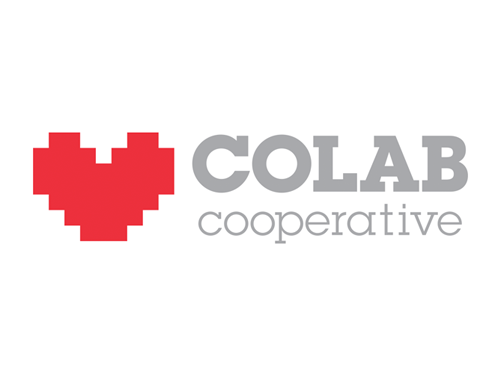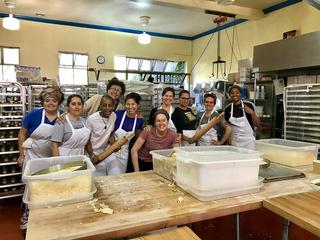Recently, we teamed up with CoLab Cooperative, a worker-owned digital agency building online infrastructure for the democratic economy (including thenextsystem.org!) for a research project to explore the many options for how cooperatives can grow and scale without letting go of key values around democratic participation and shared culture. As a rapidly growing distributed digital worker cooperative spanning three continents, CoLab felt they were in uncharted territory, and reached out to our team to help create a map that could guide their future path towards bigger scale and bigger impact. In the spirit of movement generosity, they agreed to structure this project in a way that would allow much of the research to be contributed back to the commons—the result is below. [-john]
A typology of structures for cooperative association
Formal hub structures
The following are “ideal types” of associations of cooperatives in which multiple cooperative businesses are joined together through a central “hub” organization that’s functionally distinct from the associated cooperative “spokes.” Within this simplified typology, there’s room for lots of variation. For one, these different types of hubs can be built with a wide range of legal entities and structures—nonprofits, second-order cooperatives (a cooperative with the members being themselves cooperatives), noncooperative business forms like franchise agreements, or even special purpose legal entities like 501(c)(6) nonprofit business leagues. For another, these ideal types are often mixed together as functional patterns in practice, with one hub serving more than one of the functions identified below.
Shared services hub
Backend office needs and processes may be virtually identical for cooperatives operating in the same legal context, and one pattern for cooperative association is to abstract these services out of the individual businesses and locate them within a central hub. By leveraging the economy of scale, higher capacity and higher-quality backend support can be made available to all associated cooperatives.
PROS: Very clear division of labor established essentially through contracting for services internal to the cooperative association.
CONS: Too much abstraction may result in less engagement in business at the associated coop level. Offers a largely transactional relationship with few opportunities to develop deeper mission alignment or shared culture.
EXAMPLE: One key component of the design of the Evergreen Cooperatives is Evergreen Business Services, a stand-alone, for-profit company established as a subsidiary of the nonprofit Evergreen Cooperative Corporation, which provides backend services like finance and accounting support, sales and marketing, and business development consulting. Not only does this create operational efficiencies for Evergreen, it also allows a degree of coordination around shared anchor institution clients and key community intermediaries for Evergreen’s inclusive hiring pipelines. Additionally, the services shared by the cooperatives can also be offered to unconnected external businesses, generating revenue to sustain shared service provision and further lowering costs for the associated cooperatives.
Incubation hub
In an incubation hub pattern, a central node is responsible for developing new cooperative businesses, providing them with a range of supports that can include fiscal sponsorship, back-office services, business development, marketing, and training, with the goal of launching the incubated cooperatives as independent financial entities once they are ready to stand on their own. Some incubation hubs work to develop multiple businesses in the same sector, essentially following a template for successful business replication. Others work across a variety of sectors, drawing more on its central cultural and cooperative development competency rather than on specific sectoral knowledge.
PROS: Achieves significant economies of scale by institutionalizing the knowledge of the cooperative startup process across multiple business launches.
CONS: By itself, an incubation hub doesn’t ensure continuing connection or relations of mutual support between incubated cooperatives.
EXAMPLE: The Center for Family Life (CFL) in Sunset Park, Brooklyn is part of a larger social service nonprofit, SCO Family of Services. Part of CFL’s program work includes a cooperative incubator designed to complement its more traditional workforce development and support efforts, by directly creating opportunities for dignified work and wealth building in the largely low-income and Latinx immigrant neighborhood it serves, with its first incubated enterprise, Sí Se Puede! (Yes We Can!) Cleaning Cooperative, opening for business in 2006. In addition to more traditional business development support, CFL is able to provide wraparound services designed to help community members overcome specific barriers to cooperative entrepreneurship. As of September 2017, CFL has incubated at least 11 different cooperatives.
Franchise/replication hub
A variation on the incubation hub stands up independent cooperative businesses at an earlier stage, creating new businesses to address new market opportunities in the same sector but with different (geographic) fields of activity. Franchise/replication can be a more appropriate strategy when the individual cooperative nodes and their central hub all want to be insulated from the financial risks of a new business—by standing up a new cooperative as an independent financial entity from day one, none of the associated financial risks propagate across the network or up to the hub.
PROS: Given a successful template, can be an efficient way of growing market share for the cooperative economy. Franchise fees can provide a sustainable source of funding for further replication.
CONS: Relative independence of nodes means they are essentially competitors, so fields of activity need to be clearly defined to be mutually exclusive.
EXAMPLE: The Arizmendi Association in the San Francisco Bay Area has created six worker cooperative bakery cafes using the same model since its founding in 1996. Franchise fees provide funding for a central hub, which is a cooperative whose members are the bakery cooperatives themselves, along with a technical assistance worker cooperative which provides guidance and technical assistance for the work of replication (as well as serving as a shared services hub).
Culture hub
A centralized hub can exist largely apart from any particular business function, and simply be charged with maintaining a shared culture across a network of cooperatives or social enterprises, for instance through education, convening, or other forms of exchange and communication. Such a hub can preserve a sense of shared mission and help break down isolation between smaller independent projects.
PROS: Maintains strong relative independence at the business level
CONS: Revenue model needs to be based in a shared sense of strong value proposition.
EXAMPLE: Enspiral, based largely in New Zealand, initially had a network design centered around accumulating financial resources and technical capacity in a centralized hub with a complicated formal governance model, but recently has begun to more accurately resemble a culture hub, in which the central hub exists to facilitate interchange, learning, annual gatherings, and a shared sense of social mission between disparate projects, rather than serving any particular business function (especially since the central Enspiral Services freelancers hub was factored out of the network design).
Finance hub
A key function of many central hubs is the provision of financial support to nodes in a cooperative network (most commonly in the form of revolving debt). For instance, Caja Laboral, Mondragon’s internal bank, has been generally credited with vastly accelerating the growth of the Basque coop complex. If projects generally rely on credit access to grow and scale, the availability of a central hub operated within the cooperative economy both brings down the cost of borrowing for nodes in this network and prevents leakages of accumulating capital out of the network.
PROS: At scale, finance hubs can be self-financing based on interest charged to members, although that scale is nontrivial.
CONS: Relative financial viability measured monetarily is just one lens among many that coops should use to define their relationships with each other, but a hub around credit access may be likely to elevate above others.
EXAMPLE: Shared Capital Cooperative is a lending institution owned by its members—the cooperative businesses that themselves have received loans from Shared Capital. Since its founding in 1978, Shared Capital has made over $50 million in financing available for member cooperatives, currently numbering 237. A class of individual equity investors (250 in total) also exists in the cooperative membership, but with only one collective board seat and one collective vote on governance matters.
Advocacy and field building hub
Cooperatives can create centralized hubs to advance policy that collectively benefits their network, or that more generally advocates for and advances their field of activity. Such advocacy and field building hubs are entirely distinct from business functions of the cooperatives in the network, and exist to advance functions that are beneficial to the cooperatives but also outside their capacity or competency. (In effect, these are outward facing versions of shared service hubs.)
PROS: Can provide focused capacity on problems bigger than any one cooperative can tackle on their own.
CONS: Financing these kind of advocacy hubs requires something like a dues structure, which may present challenges of scale in small networks.
EXAMPLE: The US Federation of Worker Cooperatives brings together nearly 200 worker coops in the US, funding a small advocacy and promotional team out of membership dues paid on a sliding scale proportional to member cooperative income. As a 501(c)(6), it is tax-exempt but able to pursue policy change advancing support for the worker cooperative sector through lobbying, most notably recently through acting as part of the coalition around the Main Street Employee Ownership Act. The constraints of dues funding led the Federation to establish a parallel 501(c)(3) nonprofit, the Democracy at Work Institute, in order to be able to utilize philanthropic funding to power research and education activities at a larger scale.
Central office hub
Most of the models sketched here are centered at the edges; in other words, the cooperatives in the network are more important sites of activity than the central hub, which serves a subordinate function to these nodes. At larger scales, however, the centralized hub could become more important and serve to direct and manage the overall enterprise run through the cooperative network nodes—like a C-suite directing branch offices with limited autonomy.
PROS: Economies of scale inherent in large corporations combined with more human-sized cooperatives as the local footprint.
CONS: Risk of atrophy in the capacities of local nodes to effectively practice democracy.
EXAMPLE: Founded in 1900, the Desjardins federation of credit unions in Quebec currently has nearly $300 billion CAD under management, with 7 million members and nearly 1,000 branches. Due to the increasingly technically and technologically complex banking sector, operation at this scale is far beyond the capacities of any of the individual local caisses populaires or local credit unions, and many functions relating to sophisticated financial products exist entirely within the centralized structure of the federation. Arguably, the caisses populaire are becoming essentially ceremonial with respect to the overall structure.
Mission lock hub
Another role for a central hub in a network of cooperatives is to bind them to a shared mission. A legal device, whether contractual or based on rights of shared ownership, is established to inextricably commit a cooperative business to an aspect of its social mission. Ideally, the centralized hub holding this power is also sufficiently resourced to be able to guarantee actionable enforcement. One can also identify mission-lock hubs based in certification/reputational regimes (for instance, B-Corp status), or by making access to shared service or financing conditional on adherence to specified principles.
PROS: Establishes a backstop against the corrosive effects of capital and markets.
CONS: Mission lock as a legal or financial device is really something that matters in a crisis, when things are going wrong—it doesn’t, by itself, help make sure things go right.
EXAMPLE: Evergreen Cooperative Corporation is a nonprofit corporation that holds a 10% share in each individual, for-profit Evergreen Cooperative. Beyond insuring the central hub incubating and supporting the individual cooperative, it also retains special powers to veto the decision of an individual cooperative’s board if such a decision might contravene the wider mission (to expand the democratic economy) by “demutualizing” that cooperative.
Other models for association
There are a few other possibilities for cooperative scale that don’t correspond to the hub-and-spoke model above. We’ve outlined these possibilities here as well.
Just get big! (The Assembly Model)
Growth is possible without compromising values in a cooperative business, although it requires explicit commitments to building culture and a sense of shared identity. It also requires a creative design of process as well as a willingness to embrace more representative and less direct forms of governance, as horizontal consensus mechanisms grounded in assemblies have more or less hard size limits as effective ongoing tools for self-management. While there are examples of scaled cooperative enterprises with complex internal articulations (e.g. large Mondragon businesses), a key “platform” pathway to scale seems to be the extent to which the worker cooperative resembles a coop of independent producers more than a single workplace with lots of interlocking functions. For instance, it is easy for CHCA in the Bronx to scale by adding new home care workers: the marginal cost of a new member to the backend and training capacity of the cooperative is minimal.
EXAMPLE: This article from Shareable details how Stocksy, a rapidly scaling international platform cooperative for stock photographers, is developing processes to manage democratic decision-making in a membership base that includes hundreds of people spread across the world. For instance:
“Members can initiate the resolution process in two clicks by posting an “idea for discussion” on a specialized platform on the Stocksy intranet. When an idea is posted, a round of voting begins automatically and a discussion space for that idea is created. “This first round of voting indicates whether or not membership believes the idea is one worth additional attention, providing a quick way to assess and prioritize ideas,” Cook says. “This gives all our members a chance to read, translate, talk about, and think about our resolutions.”
Of particular interest is the “rolling” annual general meeting, which has been built to encourage equitable participation across 24 hours of time zones by structuring the meeting so that members can plug into the process in a timebound but asynchronous way.
Internal differentiation
One option for effectively scaling a worker cooperative while maintaining directly democratic self-management is to simply create semi-autonomous working groups or departments within a larger structure, devolving as much decision-making power as desired to these internal units within a shared overarching governance structure.
PROS: Very little legal overhead, allowing for a lot of room to experiment, prototype, and iterate.
CONS: Very few guardrails for managing shared expectations or clearly delineating financial relationships.
EXAMPLE: As Red Emma’s in Baltimore grew, it found it cumbersome to continue to make all decisions by consensus on every operational issue. An expansion to a new location provided some clear functional articulations between the bookstore, the cafe, and the coffee-roasting parts of the business, and each of these units was given substantial authority to self-manage operations and define membership. An initial system for budgeting used a quarterly process where the full collective discussed and decided on proposals brought by departments to allocate money to staff costs or invest in infrastructure; the system has evolved to one in which each department pays a fixed share of overhead and then manages its own revenue and expenses beyond that.
Tier structures
One way of accommodating growth within a single cooperative could be to introduce tiers of membership, in which varying levels of commitment to the cooperative enterprise could be modeled explicitly as encompassing different sets of rights and responsibilities in a formalized way.
PROS: Flexibility to include different levels of members can be a key way to manage otherwise unmanageable contradictions.
CONS: Obvious possibility to reify unequal levels of democratic governance.
EXAMPLE: The Uralungal Labor Contract Cooperative Society in Kerala, India, faced with an expansion of its workforce that incorporated many migrant workers with no long-term connection to the region, created a Class-C share, available at a significant discount from normal Class-A worker-owner shares, that allow less permanent workers access to the fringe benefits enjoyed by worker-owners, but without conveying a right to a share of profit or opportunities to participate in decision making.
Loose networks
It’s always possible to have a network without a centralized hub! Such structures may be appropriate in situations where the risk of a centralized hub accumulating power over network nodes is viewed as unacceptable. Nonhierarchical networks of cooperative enterprise can be formalized through a meshwork of contractual relationships, or can exist as informal affinities and tendencies towards alignment and cooperation.
PROS: Flexibility and preservation of autonomy between nodes.
CONS: Informality and decentralization may present barriers to sustainable growth over the long haul.
EXAMPLE: The Catalan Integral Cooperative, a sprawling network of projects in and around Barcelona that includes multiple physical spaces, a custom crypto currency, a freelancer’s support cooperative, and more, functions as a loose assemblage of autonomous infrastructural committees bound together in a general assembly together with more loosely coupled associated projects, with an independent legal existence. The CIC itself has no legal existence.
Some general observations and key design principles
Transparency, simplicity, and flexibility are key. It’s tempting (perhaps especially for people in the tech sector!) to over-engineer a detailed process with lots of bells and whistles. But complication doesn’t necessarily translate to empowerment—there is a lot of overhead involved in maintaining documentation of internal processes and onboarding new people into the current structure and grounding them in its evolution. There’s also a risk of brittleness—a complex design may prove cumbersome to adapt to new situations, or may wind up being bypassed too often in practice to be truly meaningful. Where explicit decisions need to be made, they should be made as explicitly as possible, with very clear documentation of the core meaningful facts relative to the way people relate to the business.
EXAMPLE: Buffer’s salary model.https://open.buffer.com/salary-formula/
A robust revenue and resource model is necessary for central hub operations. In any hub-and-spoke design, special attention should be paid to how the hub’s operations are financed and staffed, whether this hub is tightly tied to resources and capacities generated or housed in the spokes, or more loosely coupled to the spokes with some independent sources of income and more distinct personnel. Under-resourcing the central component of your cooperative association runs the risk of creating bottlenecks for key processes or undermining its functional role in shared governance.
THIS RESEARCH MADE POSSIBLE BY:

Thanks to Stephanie Guico and Danny Spitzberg for their helpful input into this research!







